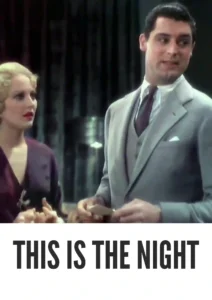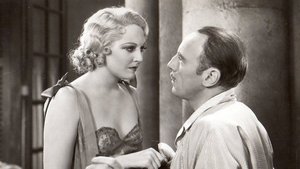Contact: [email protected]
Video Sources 0 Views
- This Is the Night


Synopsis
Table of Contents
ToggleReview: This Is the Night (1932) – A Glamorous Romantic Comedy Enchantment in Early Hollywood

Introduction
“This Is the Night” (1932) stands as a testament to the golden age of Hollywood, capturing the elegance and charm of a bygone era. In this review, we’ll explore the significance of this classic romantic comedy, its impact on audiences, and its enduring legacy in the annals of cinematic history.
Check The Full Colorized Movies List
Check Our Colorized Movies Trailer Channel
Understanding This Is the Night 1932: Director, Cast, and Genre
Directed by the talented Frank Tuttle, “This Is the Night” (1932) exemplifies the sophistication and wit of early Hollywood filmmaking. The film features a stellar cast, including the iconic Claudette Colbert, Cary Grant in his feature film debut, and the dashing Roland Young, whose comedic timing and on-screen chemistry elevate the film to new heights. Blending elements of romance, comedy, and farce, “This Is the Night” (1932) transports viewers to a world of glamour and intrigue, where love and laughter reign supreme.
Exploring the World of This Is the Night 1932: Plot and Characters
At its heart, “This Is the Night” (1932) follows the misadventures of a young married couple, played by Roland Young and Thelma Todd, whose lives are turned upside down when they become embroiled in a romantic entanglement with a dashing Frenchman, portrayed by Cary Grant. As the hilarity ensues and misunderstandings abound, the stage is set for a comedy of errors that will leave audiences in stitches and longing for more. Along the way, the characters encounter a host of eccentric personalities, each adding their own unique flavor to the proceedings and ensuring that laughter is never far away.
The Art of Film Colorization
Film colorization serves as a transformative tool that allows filmmakers to breathe new life into classic movies, enhancing their visual appeal and captivating audiences with vibrant hues. By digitally adding color to black and white films, colorization opens up new possibilities for storytelling and allows viewers to experience familiar stories in a fresh and exciting way.
Early Colored Films: A Brief History
The history of colored films stretches back to the early days of cinema, with filmmakers experimenting with various techniques to add color to their creations. From hand-painted frames to early Technicolor processes, the evolution of colored film has been marked by innovation and creativity, paving the way for the development of modern colorization techniques that continue to captivate audiences to this day.
This Is the Night 1932 and Its Early Colored Version
The decision to release “This Is the Night” (1932) in a colorized format was met with both excitement and skepticism. While some welcomed the opportunity to experience the film in vibrant color, others expressed concerns about the potential impact on its visual aesthetic. Nevertheless, the early colored version of “This Is the Night” (1932) offers viewers a fresh perspective on the classic romantic comedy, enhancing its timeless charm and immersing audiences in its glamorous world.
The Debate Over Film Colorization
The debate over film colorization continues to divide audiences and critics alike, with proponents praising its ability to breathe new life into classic movies and introduce them to a new generation of viewers, while detractors argue that it compromises the artistic integrity of the original work and diminishes its historical significance. As the debate rages on, filmmakers and audiences alike are left to ponder the merits and drawbacks of colorization in the ever-evolving landscape of cinema.
Examining This Is the Night 1932 as an Early Colored Film
As with any colorized classic, the impact of colorization on “This Is the Night” (1932) is a matter of personal interpretation. Some may argue that it enhances the film’s visual appeal and immerses viewers in its world, while others may feel that it detracts from the stark beauty of the original black and white version. Regardless of one’s stance on the issue, there’s no denying the enduring charm and timeless appeal of “This Is the Night” (1932) as a classic romantic comedy that continues to delight audiences of all ages.
Influence and Legacy: This Is the Night 1932’s Impact on Cinema
“This Is the Night” (1932) has left an indelible mark on the world of cinema, inspiring countless filmmakers and captivating audiences with its wit, charm, and sophistication. From its memorable performances to its sparkling dialogue, the film continues to resonate with viewers around the world, reaffirming its status as a beloved classic of the romantic comedy genre.
Director’s Cinematic Legacy: Beyond This Is the Night 1932
Frank Tuttle’s influence extends far beyond “This Is the Night” (1932), with a diverse body of work that continues to captivate audiences to this day. From his early days in silent cinema to his later collaborations with some of Hollywood’s biggest stars, Tuttle’s films are celebrated for their wit, style, and timeless appeal. Through his groundbreaking work, Tuttle has left an indelible imprint on the world of cinema, inspiring generations of filmmakers to follow in his footsteps.
Themes Explored in This Is the Night 1932
“This Is the Night” (1932) explores a myriad of themes, from love and betrayal to the nature of identity and the pursuit of happiness. Through its colorful characters and sparkling dialogue, the film invites viewers to ponder the complexities of human relationships and the joys and sorrows that accompany them. As audiences immerse themselves in the world of “This Is the Night” (1932), they are reminded of the universal truths that bind us together and the enduring power of laughter to light up even the darkest of nights.
Reception and Controversy Surrounding This Is the Night 1932
Upon its release, “This Is the Night” (1932) received widespread critical acclaim, with many praising its sparkling wit, memorable performances, and timeless charm. However, the decision to release the film in a colorized format sparked debate among purists, reigniting the age-old discussion surrounding film preservation and artistic integrity. Despite the controversy, “This Is the Night” (1932) remains a beloved classic that continues to delight audiences of all ages, reaffirming its status as a timeless masterpiece of the romantic comedy genre.
Where to Watch This Is the Night 1932 Online
For those eager to experience the timeless magic of “This Is the Night” (1932), the film is readily available on popular streaming platforms such as Netflix, Amazon Prime, and Hulu. Whether you choose to watch it in its original black and white format or the early colored version, “This Is the Night” (1932) promises to transport you to a world of glamour and enchantment, where laughter reigns supreme and love conquers all.
FAQs About This Is the Night 1932
Q: Is “This Is the Night” (1932) based on a true story? A: No, “This Is the Night” (1932) is a fictional romantic comedy crafted by screenwriter Benjamin Glazer, whose witty dialogue and sparkling characters captivate audiences from beginning to end.
Q: Who are the main actors in “This Is the Night” (1932)? A: “This Is the Night” (1932) features an ensemble cast led by the talented Claudette Colbert, Cary Grant, and Roland Young, whose comedic chemistry and on-screen charisma bring the film to life with charm and elegance.
Q: What awards did “This Is the Night” (1932) win? A: While “This Is the Night” (1932) did not win any major awards, it received critical acclaim for its sparkling wit, memorable performances, and timeless charm.
Q: Why was “This Is the Night” (1932) released in a colorized format? A: The decision to release “This Is the Night” (1932) in color was made to introduce the film to a new generation of viewers and enhance its visual appeal for modern audiences. While the choice to colorize the film sparked debate among purists, it ultimately allowed “This Is the Night” (1932) to reach a wider audience and ensure its continued relevance in the annals of cinematic history.
Conclusion
In “This Is the Night” (1932), audiences are whisked away on a whirlwind adventure filled with romance, laughter, and glamour. Whether viewed in its original black and white format or the early colored version, the film remains a timeless masterpiece that continues to captivate audiences with its wit, charm, and sophistication. So, whether you’re a seasoned cinephile or a casual moviegoer, take a moment to experience the magic of “This Is the Night” (1932) and discover the enchantment of Hollywood’s golden age.











